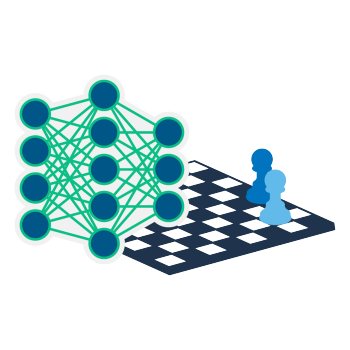ANALYTICS INSIGHTS
Transform data into the best decisions
Recent Analytics Insights
-
 What is synthetic data? And how can you use it to fuel AI breakthroughs?There's no shortage of data in today's world, but it can be difficult, slow and costly to access sufficient high-quality data that’s suitable for training AI models. Learn why synthetic data is so vital for data-hungry AI initiatives, how businesses can use it to unlock growth, and how it can help address ethical challenges.
What is synthetic data? And how can you use it to fuel AI breakthroughs?There's no shortage of data in today's world, but it can be difficult, slow and costly to access sufficient high-quality data that’s suitable for training AI models. Learn why synthetic data is so vital for data-hungry AI initiatives, how businesses can use it to unlock growth, and how it can help address ethical challenges.
-
 What are AI hallucinations?Separating fact from AI-generated fiction can be hard. Learn how large language models can fail and lead to AI hallucinations – and discover how to use GenAI responsibly.
What are AI hallucinations?Separating fact from AI-generated fiction can be hard. Learn how large language models can fail and lead to AI hallucinations – and discover how to use GenAI responsibly.
-
 What are chatbots?Chatbots are a form of conversational AI designed to simplify human interaction with computers. Learn how chatbots are used in business and how they can be incorporated into analytics applications.
What are chatbots?Chatbots are a form of conversational AI designed to simplify human interaction with computers. Learn how chatbots are used in business and how they can be incorporated into analytics applications.
-
 4 strategies that will change your approach to fraud detection기술의 발전에 힘입어 금융 기관들은 그 어느 때보다 우수한 사기 탐지 기능으로 무장하고 있습니다. 방어망를 대폭 강화할 수 있는 4가지 방법을 소개합니다.
4 strategies that will change your approach to fraud detection기술의 발전에 힘입어 금융 기관들은 그 어느 때보다 우수한 사기 탐지 기능으로 무장하고 있습니다. 방어망를 대폭 강화할 수 있는 4가지 방법을 소개합니다.
-
 Analytics leads to lifesaving cancer therapiesA long-shot treatment offers hope to 10-year-old Harrison after he learns the DNA profile of his cancer is resistant to chemo. Find out how data and analytics play a role in cancer research and cancer treatments that are saving lives.
Analytics leads to lifesaving cancer therapiesA long-shot treatment offers hope to 10-year-old Harrison after he learns the DNA profile of his cancer is resistant to chemo. Find out how data and analytics play a role in cancer research and cancer treatments that are saving lives.
-
 Key questions to kick off your data analytics projectsThere’s no single blueprint for starting a data analytics project. Technology expert Phil Simon suggests these 10 questions as a guide.
Key questions to kick off your data analytics projectsThere’s no single blueprint for starting a data analytics project. Technology expert Phil Simon suggests these 10 questions as a guide.
-
 Analytics tackles the scourge of human traffickingVictims of human trafficking are all around us. From forced labor to sex work, modern-day slavery thrives in the shadows. Learn why organizations are turning to AI and big data analytics to unveil these crimes and change future trajectories.
Analytics tackles the scourge of human traffickingVictims of human trafficking are all around us. From forced labor to sex work, modern-day slavery thrives in the shadows. Learn why organizations are turning to AI and big data analytics to unveil these crimes and change future trajectories.
-
 Analytics: A must-have tool for leading the fight on prescription and illicit drug addictionStates and MFCUs now have the analytics tools they need to change the trajectory of the opioid crisis by analyzing data and predicting trouble spots – whether in patients, prescribers, distributors or manufacturers. The OIG Toolkit with free SAS® programming code makes that possible.
Analytics: A must-have tool for leading the fight on prescription and illicit drug addictionStates and MFCUs now have the analytics tools they need to change the trajectory of the opioid crisis by analyzing data and predicting trouble spots – whether in patients, prescribers, distributors or manufacturers. The OIG Toolkit with free SAS® programming code makes that possible.
-
 Viking transforms its analytics strategy using SAS® Viya® on AzureViking is going all-in on cloud-based analytics to stay competitive and meet customer needs. The retailer's digital transformation are designed to optimize processes and boost customer loyalty and revenue across channels.
Viking transforms its analytics strategy using SAS® Viya® on AzureViking is going all-in on cloud-based analytics to stay competitive and meet customer needs. The retailer's digital transformation are designed to optimize processes and boost customer loyalty and revenue across channels.
-
Detect and prevent banking application fraudCredit fraud often starts with a falsified application. That’s why it’s important to use analytics starting at the entrance point. Learn how analytics and machine learning can detect fraud at the point of application by recognizing the biggest challenge – synthetic identities.
-
Public health infrastructure desperately needs modernizationPublic health agencies must flex to longitudinal health crises and acute emergencies – from natural disasters like hurricanes to events like a pandemic. To be prepared, public health infrastructure must be modernized to support connectivity, real-time data exchanges, analytics and visualization.
-
SAS CIO: Why leaders must cultivate curiosity in 2021With the change we’re all facing this year, CIOs should be counting on curiosity to play a crucial role in how we’re going to meet the challenges that lie ahead. From the moment COVID-19 hit, our IT organization has relied on curiosity – that strong desire to explore, learn, know - to fuel the urgent changes required. And it’s curiosity that will enable us to meet the needs of the future of work post-pandemic.
-
Load Forecasting: Ensuring supply meets energy demandLoad forecasting helps energy suppliers meet demand for residential and commercial customers. As renewable energy resources increase, the necessity for a technology platform that adapts to load forecasting requirements becomes crucial.
-
Five ways your organization can enhance resilience for years to comeInnovation, agility and customer-centricity frequently top the list of companies’ strategic objectives, and now the most urgent priority is resilience. Given this new urgency, it’s worth taking a close look at the underpinnings of resilience and how they could be applied in any industry. This article explores how analytics can help boost resilience and includes key elements to keep your organization resilient.
-
Resilience in the face of unpredictabilityUnpredictability can “shatter and reshape” a society. And in these unpredictable times, it is important to remain resilient and be prepared to bounce back. This article explores what it truly means to be resilient, how to build it, and how analytics can help you act when your resilience is tested.
-
Homelessness data holds insights to a hidden problemSAS partnered with The Carying Place, an organization that supports working homeless families, to find new ways to measure indicators of participant success and provide families the help they deserve.
-
Finding COVID-19 answers with data and analyticsLearn how data plays a role in optimizing hospital resources, understanding disease spread, supply chain forecasting and scientific discoveries.
-
How health care leaders deployed analytics when crisis hitDuring the COVID-19 pandemic, some health care providers were well-positioned to respond to rapid changes in demand. The factor that most distinguished them was that they already had a strong capacity in place for using data to inform decisions. Read about three key takeaways from their experiences.
-
Situational awareness guides our responses – routine to crisisMany circumstances call for situational awareness – that is, being mindful of what’s present and happening around you. The COVID-19 pandemic heightened this need, as leaders across industries used analytics and visualization to gain real-time situational awareness and respond with fast, critical decisions.
-
A data scientist’s views on data literacyData literacy is a social imperative – and understanding data and data analysis is critical for being a responsible citizen. Get a data scientist and teacher's perspective on the value of having foundational knowledge so you can more easily tell data facts from data fiction.
Send SAS Insights straight to your inbox




